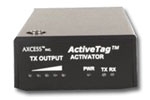Key-Box Key Management Systems
Division of Time Access Systems Inc
Questions? We'd love to hear from you.
What's New
Activator
Model: AXSACTIV
The ActiveTag™ system is based on receivers, antennas, and activators. The activator works by using internal or external antennas and transmits encrypted data to the proper tags. These tags then send the information, including tag identifiers, to the receiver on the network. The antennas are also used to hook up with the activator in order to implement hidden zones of coverage that are necessary for activities such as personnel and asset monitoring.
Activator:
The main pillar of the ActiveTag™ control point architecture is the activator. This piece of equipment works by itself as a transmitter that hooks up to an antenna specialized for a certain application. A low frequency activation signal that will activate specific tags as they come through the field of the antenna is consistently transmitted. This process typically works by having the standard activator add its location ID directly to the tag itself. This information, along with the unique tag ID, is resent to showcase the exact location, where activation occurs. Since the standard activator can have its power output modified, the area of activation can be customized; control points can be, therefore, as large as tens of feet in diameter, or as small as a few feet.
The standard activator has the ability to be altered and set up with a user-created location ID by using serial port or jumpers. The unit comes with the added benefit of efficient and easy installation, along with the ability to provide coverage around many different types of areas and landscapes, including interior zones, perimeter doors, and vehicle lanes.





